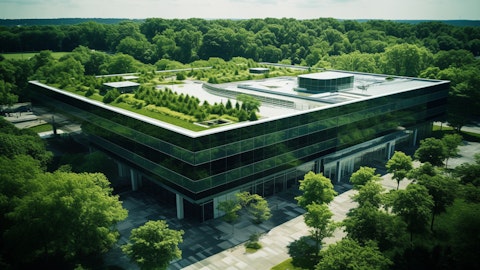Peter Vanacker: Happy birthday, Dave. We heard that you have your birthday today. Good question. If I take 1 step back on the I&D business in Q4, maybe a couple of numbers and stay with me so $265 million, excluding identified items is the EBITDA that we generated in Q4. But one needs to take into consideration, of course, that we had a heavy LIFO impact of $95 million. So if I add the LIFO impact of $95 million, then exit the underlying results were $360 million for Q4 comparing to Q4 2022 which was $291 million. So a quite underlying performance, good quarter in IND and I did not even take into consideration the fact that we had scheduled turnarounds bottleneck as well as in Bayport. So we alluded to that, in our guidance at the time when we released the Q3 results of an impact of about $120 million.
So we laying quite a good quarter in IND. And of course, part of that was also due to the fact that we very successfully started up our PO/TBA plant. The new PO/TBA plant, we alluded to mid-cycle margins, $450 million. We said last year in year one. So that means 2023. We would run at a minimum of 50% nameplate capacity. We overachieved that target. We ran at approximately a little bit more than 60%, I would say. And then, also when we look at this year, we will continue to ramp up, and we will do it in a very disciplined way, reflecting on market demand for propylene oxide and oxyfuels. But one may see further progress, I would say, probably going to 70%, maybe exceeding 70% capacity utilization. And then when we move into 2025, that’s where one would see the full benefit of the PO/TBA plant in terms of capacity utilization.
Operator: Our next question comes from the line of Vincent Andrews with Morgan Stanley. Please proceed with your question.
Vincent Andrews: Just on the value enhancement program. I’m just trying to understand the impact to ’23 and ’24, a bit better. If we just sort of kind of look at a ratio of sort of what that 2017 to 2019 EBITDA was at Lyondell then versus what it was in 2023. If we apply that ratio to the VEP numbers, would that be about right in terms of what you enjoyed from it in ’23 and what you expect in ’24?
Michael McMurray: Yes. What I’d say, I mean, hopefully, you heard my prepared remarks, Vincent, so the benefit, the actual benefit in our P&L for 2023 was approximately $300 million. And then we guided for ’24 for an exit run rate of $600 million. Now if you’re trying to draw a line from ’23 to ’25, it looks like that kind of the pace of change slows a bit. But keep in mind that last year, we focused on low-hanging fruit, things that didn’t require investment and that we could execute upon very quickly. So we’re in kind of building up projects again as we sit in this year, but we have high confidence in the outlook that we gave up to $1 billion in 2025 and again, $300 million of P&L benefit in ’23, actual.
Operator: Our next question comes from the line of Michael Sison with Wells Fargo. Please proceed with your question.
Michael Sison: Cheers, in terms of 2024 a lot of chemical companies you’ve reported thus far has sort of said their earnings could recover or be better in ’24 versus ’23. It sounds like your first half is going to be a little bit challenged with demand being weaker and the second half being a little bit better. So when you sort of total up potentially what you see in ’24, should earnings be up, flat or down or just maybe directionally for the full year, how do you think about the setup for early?
Peter Vanacker: Well, Michael, you said it yourself. I mean, Q1, still modest Q2 seasonal demands have been picking up. And then what I said at the beginning also second half of the year, we expect at least, that we will see interest rates going down demand for durable goods, I mean going up, some recovery in Europe, some recovery in China. So as a consequence, if you added all that, one would expect that earnings are going to be better than last year.
Michael McMurray: But mostly in the second half.
Operator: Our next question comes from the line of Arun Viswanathan with RBC Capital Markets. I’m sorry. We’ll go on to our next question, comes from the line of Kevin McCarthy with Vertical Research Partners. Please proceed with your question.
Kevin McCarthy: In 2024, would you expect your regional mix of earnings to differ materially from 2023. Part of the reason I ask is it looks like you’re guiding to a tax rate of 20% and often regional mix is the reason behind that, but perhaps there are other reasons you might call out. Maybe you could just kind of talk through the dynamics there would be helpful.
Michael McMurray: Yes. I’m happy to talk through it. So yes, I mean, the ETR, we guided to of 20% is up roughly 1 percentage point versus what was in 2023. So not a huge story. There’s a few give and takes. Now we did guide our cash tax rate to be up a couple of percentage points versus last year and also our ETR from 2023 and that’s largely driven by a decrease in U.S. tax depreciation and also the gain on the sale of our EO&D business. Hopefully, that’s helpful.
Operator: Our next question comes from the line of John Roberts with Mizuho. Please proceed with your question.
John Roberts: Could we get an update on your China operations both in PO styrene and your polyolefins JVs?
Peter Vanacker: Yes, John. Welcome back. Let me give that question to Ken. The opportunity?
Ken Lane: Yes, sure. I’ll take a question for O&P and then maybe Kim, you can comment on IND. But for O&P, we continue to operate the joint venture at technical minimums. The focus really is on finding better product mix and customer mix in region. Our focus when we entered that joint venture was to build out an increased presence in the domestic market because we do market the high-density polyethylene and polypropylene from the asset. The team did a great job with that last year. So earnings, of course, are still very challenged in China. If you look at average margins, they’re still slightly negative which we’re seeing that in our asset. Even with a new world-scale asset, it still is a very challenging market, and we expect to start to see some improvement in that in the second half of the year. But so far, demand has been, I’d say, modestly improving, but haven’t seen really an improvement in margins yet, Kim?
Kim Foley: I would say as it relates to the joint ventures we have on the propylene oxide guide. We ran both of those JVs above 95% operating rates last year, excluding a turnaround, which was significantly higher than other PO plants in that region. As Ken alluded to, the margins were rather thin. We saw high raw material costs, and we also saw high utilities. But as we’ve mentioned before, these are the best technologies that we have in the region. They are very cost competitive. They sit on integrated sites owned by a very good operator with expertise in both of these technologies. And we think as we go forward, we have huge potential here.
Peter Vanacker: And may I add to that also, you probably noticed some news flow around China, phasing out chlorine-based propylene oxide technologies towards 2025. The majority of propylene oxide capacity in China that would be phased out for time which also fits for us very well together with our global strategy, the successful start-up of our PO/TBA plant. And we are running this business successfully under Kevin’s leadership from a global basis.
Operator: Our next question comes from the line of Mike Leithead with Barclays. Please proceed with your question.
Mike Leithead: I wanted to add around O&P EAI, EBITDA has been below breakeven, I think 4 out of the last 6 quarters. And I appreciate demand isn’t great across most markets. But it just seems like there’s been a bit of a shift here versus the profitability in the past decade. So do we need to take a bigger restructuring overhaul to make this business profitable again? Do we need to wait for the world to get better? I mean just how are you approaching that business here in ’24?
Peter Vanacker: Yes. Thank you, Mike. A very good question. And you’ve seen from our actions already last year that we are turning around every stone. We did shut down one line in Brindisi, which is an important capacity. We’ve seen that there has been a couple of other announcements in the marketplace in terms of consolidations. We continue to look, of course, at the entire portfolio. That’s what you would expect us to do. But having said that, I also reflect back on Q4. So in a big picture on for the company for us, was towards the end of the year, we wanted to also optimize our cash flow and working capital. And we freed up about $700 million in working capital in that Q4. And as a consequence, of course, also can see this business towards lower than what we had originally guided to.
75% of capacity utilization was the guidance. We reduced at really surprisingly low levels 65% of our capacity utilization. Again, in the context of also with the current market environment, optimizing our working capital. Anything you want to add?
Ken Lane: No, that’s it. I mean that just impacted the P&L with the absorption of the fixed costs that go along with that. But we pulled hard on the working capital lever, and we’re going to continue to stay focused on maximizing cash flow. Challenging environment.





